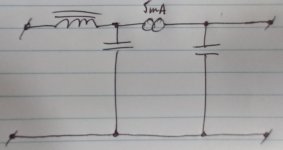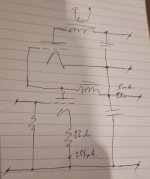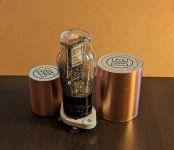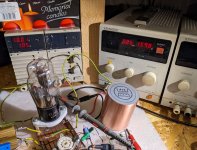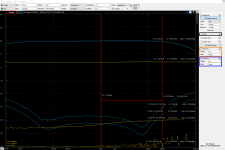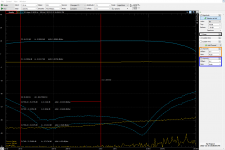IMHO OPT/choke loaded preamp requires active HT PSU.
I am also collecting parts for a choke loaded DHT stage, and similar to Robert I am not 'up to date'. What are the favored regulators these days?.
Thank you
Preamp practically requiring -almost- constant current, so shunt type regulators (as Salas SSHV2) good for it.
Any subjective impression of SSHV2 v Maida reg. Also, why not filter (series) CCS to final filter cap for 5mA Ip load?
Again, thanks
Again, thanks
I use few Maida II regulators for power amps, but for preamp or phono the shunt type regulators sounds better.Any subjective impression of SSHV2 v Maida reg. Also, why not filter (series) CCS to final filter cap for 5mA Ip load?
Could you explain what you mean this filtering (sketch)?
I've never used a HT reg. Always chokes. Can you briefly say if or how regs are better than just CLCRC with a nice big choke?I use few Maida II regulators for power amps, but for preamp or phono the shunt type regulators sounds better.
What's the goal?I've never used a HT reg. Always chokes. Can you briefly say if or how regs are better than just CLCRC with a nice big choke?
Using HT supply with simple AC coupled SE tube?
The CL/LC chain is good for this, if hum is enough low.
Using HT supply for /full/ DC coupled SE, where power tube bias depends of previous stage DC voltage?
It requires careful planning if you want to use unregulated voltages.
Sometimes it's working, but some designs requiring regulated voltages.
I've been using for decades for example phono with CLCLCRC filtering, but appropriate shunt type regulator gives better (silent, lower -almost fixed- impedance up to few MHz range etc.)
Ok thanks.I use few Maida II regulators for power amps, but for preamp or phono the shunt type regulators sounds better.
Could you explain what you mean this filtering (sketch)?
Yes, as attached. CCS would provide ripple filter, isolation and set the plate current.
Tube stage choke loaded 9k type DHT at 5mA.
It seems simple and effective .. but I don't see anyone using it (and perhaps there is a reason for this).
Attachments
CCS in series with the tube stage will result in an unstable voltage for the active stage to work with; and the signal-impedance of the supply will make the tube appear unstable.
A shunt regulator uses a CCS in the same way, but adds a voltage shunt in parallel with the load. This forces a fixed voltage, and low impedance.
The simplest shunt is just a zener diode. The 100 to 150V types could be used in this position if you want to try it.
Two precautions are needed:
1. RC filtering needed, to reduce the mV levels of broadband noise generated by the diodes; this noise is lower than typical 100-120Hz ripple, and LF instability found in unregulated DC supplies.
2. Accept that there with be a few volts of DC drift, as the zeners warm up. Should not be a problem for choke loaded stages.
You can also try series-connecting twenty BZX55C5V1 or 5V6 diodes; the noise and drift is lower for this case.
Or, use a real shunt regulator. I will have a new solution for this shortly.
A shunt regulator uses a CCS in the same way, but adds a voltage shunt in parallel with the load. This forces a fixed voltage, and low impedance.
The simplest shunt is just a zener diode. The 100 to 150V types could be used in this position if you want to try it.
Two precautions are needed:
1. RC filtering needed, to reduce the mV levels of broadband noise generated by the diodes; this noise is lower than typical 100-120Hz ripple, and LF instability found in unregulated DC supplies.
2. Accept that there with be a few volts of DC drift, as the zeners warm up. Should not be a problem for choke loaded stages.
You can also try series-connecting twenty BZX55C5V1 or 5V6 diodes; the noise and drift is lower for this case.
Or, use a real shunt regulator. I will have a new solution for this shortly.
CCS in series with the tube stage will result in an unstable voltage for the active stage to work with; and the signal-impedance of the supply will make the tube appear unstable.
Thanks.
Plate voltage sets as per grid bias and plate current for the individual tube sample, this is no problem for me and actually preferable as I wish to set optimum air gap of the plate choke without having to select tubes.
My criteria is low noise and not a fixed plate voltage (as such).
I have this up and running at 20mA for a driver stage for some time now, without any apparent degradation compared with the same CCS feeding a stack of VR tubes (0B2 + 0C2) and came about because I couldn't adjust the (VR reg) B voltage to get the plate current that I wanted.
Are you able to comment further on 'the signal impedance of the supply' and the implications on potential audio performance, please. I was/am thinking the CCS is essentially a brick wall to AC and the impedance is simply Xc of the capacitor.
I am thinking to change to a 'known good' SS regulator (assume they can all be made as adjustable) if warranted - but it's hard to know because I've not seen any discussions on this type of CCS plus cap filter - and I certainly welcome them. Again, thank you.
As to newly developed products, of course I wish the proprietors well, but my days of buying first run or revision of anything are over.. 😉
Last edited:
The T-Reg is a series, not a shunt, regulator. I don't know how your application might influence choosing between the two, or what your thoughts might be about the advantages either way. I happen to view arguments for shunt regs with greater favour.
Robert
Robert
Either will work in my application so long as adjustable. This is something the CCS fed shunt cap avoids completely - you can plug in any input tube and the sample to sample variation has no impact to the bias of the output stage whatsoever. Again, I never see it anywhere before.
Re series vs shunt, I know preconceived notions based upon AC signal loop control, and I think the same, but .. the T-Reg was designed by someone who also knows these things and hard to imagine he'd introduce an inferior product and put his name to it.
Anywsy, I'll build the shunt portion of the SSHV2 reg based upon Euro21s comment and listen/compare. I think that is the only way forward from here.
Re series vs shunt, I know preconceived notions based upon AC signal loop control, and I think the same, but .. the T-Reg was designed by someone who also knows these things and hard to imagine he'd introduce an inferior product and put his name to it.
Anywsy, I'll build the shunt portion of the SSHV2 reg based upon Euro21s comment and listen/compare. I think that is the only way forward from here.
Following your build with much interest! I still use chokes but open to the idea of a reg.Anyway, I'll build the shunt portion of the SSHV2 reg based upon Euro21s comment and listen/compare. I think that is the only way forward from here.
Cheers Andy. FWIW, if speakers were not 115dB efficient and if cap coupled, I would just use cLCLC.
Merry Christmas!!!
Reading some pages of this thread and being challenged to a minimalistic approach I made some tests with my newly developed interstage transformer, for triode 26 and alike, less bulky than the mainstream in my opinion. As you can see, regular DC power supplies, nothing fancy and the results are speaking for themselves 🙂
Happy holidays!
PS. In one of the attached photos a size comparison with 26 and the (smaller) input transformer.
Reading some pages of this thread and being challenged to a minimalistic approach I made some tests with my newly developed interstage transformer, for triode 26 and alike, less bulky than the mainstream in my opinion. As you can see, regular DC power supplies, nothing fancy and the results are speaking for themselves 🙂
Happy holidays!
PS. In one of the attached photos a size comparison with 26 and the (smaller) input transformer.
Attachments
That's a good figure for Lpri and with capacitance low enough for good HF as well.
But output impedance will be more than 7,000 ohm .. (?)
Can wind 160H+ plate choke gapped for 4 to 7 mA? 🙂
But output impedance will be more than 7,000 ohm .. (?)
Can wind 160H+ plate choke gapped for 4 to 7 mA? 🙂
Last edited:
- Home
- Amplifiers
- Tubes / Valves
- #26 pre amp
